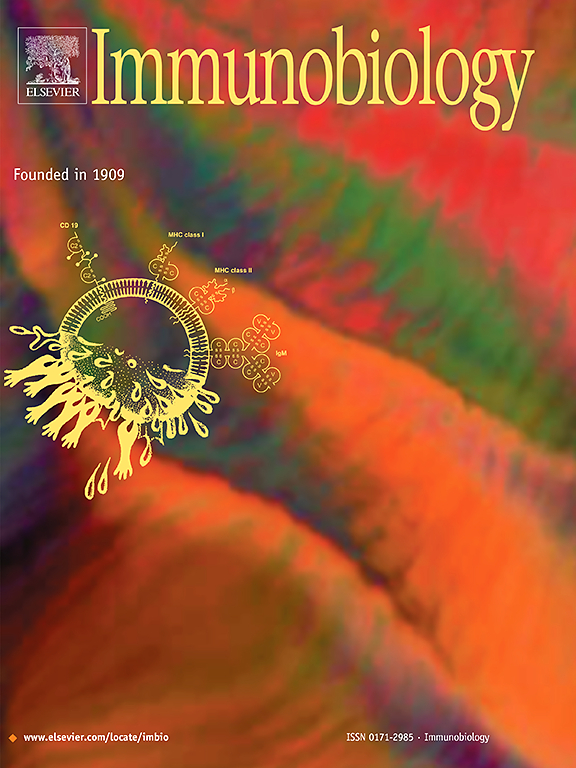自身免疫在肉芽肿性小叶性乳腺炎发病机制中的作用
IF 2.3
4区 医学
Q3 IMMUNOLOGY
引用次数: 0
摘要
目的肉芽肿性小叶性乳腺炎(GLM)是一种低缓解率、高复发率的慢性乳腺炎症。本研究旨在探讨GLM患者自身免疫特征及其与GLM发病机制的相关性。方法对2021年7月至2022年7月在曙光医院收治的GLM患者和纤维腺瘤(FA)对照组的样本进行分析。患者(107例GLM, 73例FA)进行体液免疫(C3、C4、IgG、IgM、IgE和IgA)、细胞免疫(CD3+CD4+ T细胞、CD3+CD8+ T细胞、调节性T细胞和CD4/CD8比值)和细胞因子(IL-1β、IL-6、IL-8、IL-10、IL-12和TNF-α)检测。免疫组织化学染色(10个GLM, 10个FA正常组织)检测IL-1β、IL-6、CD86和CD206,免疫荧光(3个GLM, 3个FA正常组织)检测CD86和CD206的表达。采用logistic回归进行多因素分析。结果glm以肉芽肿为主,伴非干酪化坏死和炎性细胞浸润。GLM患者C3 (P <;0.001), C4 (P <;0.001), IgE (P <;0.05), IgA (P <;0.05), IL-6 (P <;0.001), IL-8水平(P <;0.05)。在免疫组织化学和免疫荧光染色中,GLM中M1 (CD86)和M2 (CD206)巨噬细胞标志物均显著高于对照组(P <;0.05)。多因素logistic回归分析显示,生育史(OR = 7.011, P <;0.01)和C3表达水平(OR = 5565.570, P <;0.001)是GLM的独立因素。结论M1和M2巨噬细胞升高在GLM炎症中的重要作用。GLM与生殖史、C3、C4、IgE、IgA、IL-6、IL-8相关,生殖史和C3为独立危险因素。本文章由计算机程序翻译,如有差异,请以英文原文为准。
The Autoimmune Profiles in the Etiopathogenesis of Granulomatous Lobular Mastitis
Objectives
Granulomatous lobular mastitis (GLM) is a chronic breast inflammation with low remission and high recurrence. This study aimed to investigate GLM patients' autoimmune profiles and their correlation with GLM etiopathogenesis.
Methods
Samples from GLM patients and fibroadenoma (FA) controls admitted to Shuguang Hospital between July 2021 and July 2022 were analyzed. Patients (107 GLM, 73 FA) underwent humoral immunity (C3, C4, IgG, IgM, IgE and IgA), cellular immunity (CD3+CD4+ T cells, CD3+CD8+ T cells, regulatory T cells and CD4/CD8 ratio) and cytokines (IL-1β, IL-6, IL-8, IL-10, IL-12 and TNF-α) tests. Immunohistochemical staining (10 GLM, 10 FA normal tissues) detected IL-1β, IL-6, CD86 and CD206, and immunofluorescence (3 GLM, 3 FA normal tissues) evaluated CD86 and CD206 expression. Multivariate analysis was done using logistic regression.
Results
GLM featured granulomas with non-caseation necrosis and inflammatory cell infiltration. GLM patients showed higher C3 (P < 0.001), C4 (P < 0.001), IgE (P < 0.05), IgA (P < 0.05), IL-6 (P < 0.001), and IL-8 levels (P < 0.05). M1 (CD86) and M2 (CD206) macrophage markers were significantly higher in GLM than controls in both immunohistochemical and immunofluorescent staining (P < 0.05). The multivariate logistic regression analysis revealed that reproductive history (OR = 7.011, P < 0.01) and C3 expression level (OR = 5565.570, P < 0.001) were independent factors of GLM.
Conclusions
The results highlighted the crucial role of elevated M1 and M2 macrophages in GLM inflammation. GLM was associated with reproductive history, C3, C4, IgE, IgA, IL-6, and IL-8, with reproductive history and C3 as independent risks.
求助全文
通过发布文献求助,成功后即可免费获取论文全文。
去求助
来源期刊

Immunobiology
医学-免疫学
CiteScore
5.00
自引率
3.60%
发文量
108
审稿时长
55 days
期刊介绍:
Immunobiology is a peer-reviewed journal that publishes highly innovative research approaches for a wide range of immunological subjects, including
• Innate Immunity,
• Adaptive Immunity,
• Complement Biology,
• Macrophage and Dendritic Cell Biology,
• Parasite Immunology,
• Tumour Immunology,
• Clinical Immunology,
• Immunogenetics,
• Immunotherapy and
• Immunopathology of infectious, allergic and autoimmune disease.
 求助内容:
求助内容: 应助结果提醒方式:
应助结果提醒方式:


